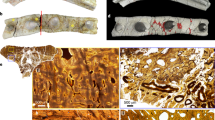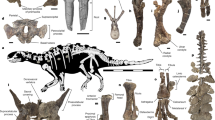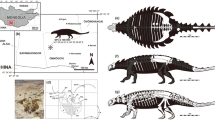Abstract
The armoured ankylosaurian dinosaurs are best known from Late Cretaceous Northern Hemisphere ecosystems, but their early evolution in the Early–Middle Jurassic is shrouded in mystery due to a poor fossil record1,2. Spicomellus afer was suggested to be the world’s oldest ankylosaur and the first from Africa, but was based on only a single partial rib from the Middle Jurassic of Morocco3. Here we describe a new, much more complete specimen that confirms the ankylosaurian affinities of Spicomellus, and demonstrates that it has uniquely elaborate dermal armour unlike that of any other vertebrate, extant or extinct. The presence of ‘handle’ vertebrae in the tail of Spicomellus indicates that it possessed a tail weapon, overturning current understanding of tail club evolution in ankylosaurs, as these structures were previously thought to have evolved only in the Early Cretaceous4. This ornate armour may have functioned for display as well as defence, and a later reduction to simpler armour with less extravagant osteoderms in Late Cretaceous taxa might indicate a shift towards a primarily defensive function, perhaps in response to increased predation pressures or a switch to combative courtship displays.
This is a preview of subscription content, access via your institution
Access options
Access Nature and 54 other Nature Portfolio journals
Get Nature+, our best-value online-access subscription
$32.99 / 30 days
cancel any time
Subscribe to this journal
Receive 51 print issues and online access
$199.00 per year
only $3.90 per issue
Buy this article
- Purchase on SpringerLink
- Instant access to full article PDF
Prices may be subject to local taxes which are calculated during checkout



Similar content being viewed by others
Data availability
All data, code and the phylogenetic matrix are available in the Supplementary Information.
References
Raven, T. J., Barrett, P. M., Joyce, C. B. & Maidment, S. C. R. The phylogenetic relationships and evolutionary history of the armoured dinosaurs (Ornithischia: Thyreophora). J. Syst. Palaeontol. 21, 2205433 (2023).
Arbour, V. M. & Currie, P. J. Systematics, phylogeny and palaeobiogeography of the ankylosaurid dinosaurs. J. Syst. Palaeontol. 14, 385–444 (2016).
Maidment, S. C. R. et al. Bizarre dermal armour suggests the first African ankylosaur. Nat. Ecol. Evol. 5, 1576–1581 (2021).
Arbour, V. M. & Currie, P. J. Ankylosaurid dinosaur tail clubs evolved through stepwise acquisition of key features. J. Anat. 227, 514–523 (2015).
Galton, P. M. Armoured dinosaurs (Ornithischia: Ankylosauria) from the Middle and Upper Jurassic of England. Geobios 13, 825–837 (1980).
Bestwick, J., Pond, S., Oliver, C. L., Nunn, M. & Smith, A. S. A new ankylosaurian osteoderm from the Middle Jurassic Oxford Clay Formation, United Kingdom. Proc. Yorks. Geol. Soc. 65, pygs2023-011 (2024).
Wills, S., Underwood, C. J. & Barrett, P. M. A hidden diversity of ornithischian dinosaurs: U.K. Middle Jurassic microvertebrate faunas shed light on a poorly represented period. J. Vert. Paleontol. 43, e2323646 (2023).
Salgado, L. & Gasparini, Z. Reappraisal of an ankylosaurian dinosaur from the Upper Cretaceous of James Ross Island (Antarctica). Geodiversitas 28, 119–135 (2006).
Soto Acuña, S., Vargas, A. O. & Kaluza, J. E. A new look at the first dinosaur discovered in Antarctica: reappraisal of Antarctopelta oliveroi (Ankylosauria: Parankylosauria). Adv. Polar Sci. 35, 78–107 (2024).
Leahey, L. G., Molnar, R. E., Carpenter, K., Witmer, L. M. & Salisbury, S. W. Cranial osteology of the ankylosaurian dinosaur formerly known as Minmi sp. (Ornithischia: Thyreophora) from the Lower Cretaceous Allaru Mudstone of Richmond, Queensland, Australia. PeerJ 3, e1475 (2015).
Soto-Acuña, S. et al. Bizarre tail weaponry in a transitional ankylosaur from subantarctic Chile. Nature 600, 259–263 (2021).
Riguetti, F. J. et al. A new small-bodied ankylosaurian dinosaur from the Upper Cretaceous of north Patagonia (Río Negro Province, Argentina). J. Syst. Palaeontol. 20, 2137441 (2022).
Arbour, V. M., Burns, M. E. & Sissons, R. L. A redescription of the ankylosaurid dinosaur Dyoplosaurus acutosquameus (Ornithischia: Thyreophora) and a revision of the genus. J. Vertebr. Paleontol. 29, 1117–1135 (2009).
Arbour, V. M. & Evans, D. C. A new ankylosaurine from the Judith River Formation of Montana, USA, based on an exceptional specimen with soft tissue preservation. R. Soc. Open Sci. 4, 161086 (2017).
Maidment, S. C. R., Norman, D. B., Barrett, P. M. & Upchurch, P. Systematics and phylogeny of Stegosauria (Dinosauria: Ornithischia). J. Syst. Palaeontol. 6, 367–407 (2008).
Burns, M. E., Tumanova, T. A. & Currie, P. J. Postcrania of juvenile Pinacosaurus grangeri (Ornithischia: Ankylosauria) from the Upper Cretaceous Alagteeg Formation, Aleg Teeg, Mongolia: implications for ontogenetic allometry in ankylosaurs. J. Paleontol. 89, 168–182 (2015).
Garcia, G. & Pereda Suberbiola, X. A new species of Struthiosaurus (Dinosauria: Ankylosauria) from the Upper Cretaceous of Villeveyrac (southern France). J. Vertebr. Paleontol. 23, 156–165 (2003).
Kinneer, B., Carpenter, K. & Shaw, A. Redescription of Gastonia burgei (Dinosauria: Ankylosauria, Polacanthidae) and description of a new species. N. Jb. Geol. Paläont. Abh. 282, 37–80 (2016).
Raven, T. J., Barrett, P. M., Pond, S. B. & Maidment, S. C. R. Osteology and taxonomy of British Wealden supergroup (Berriasian–Aptian) ankylosaurs (Ornithischia, Ankylosauria). J. Vert. Paleontol. 40, e1826956 (2020).
Pereda Suberbiola, X. & Barrett, P. M. A systematic review of ankylosaurian dinosaur remains from the Albian–Cenomanian of England. Spec. Pap. Palaeontol. 60, 177–208 (1999).
Kirkland, J. I. & Carpenter, K. North America’s first pre-Cretaceous ankylosaur (Dinosauria) from the Upper Jurassic Morrison Formation of western Colorado. BYU Geol. Stud. 40, 25–42 (1994).
Kirkland, J. I. A polacanthine ankylosaur (Ornithischia: Dinosauria) from the Early Cretaceous (Barremian) of eastern Utah. Bull. N. M. Mus. Nat. Hist. Sci. 14, 271–281 (1998).
Pond, S. et al. Vectipelta barretti, a new ankylosaurian dinosaur from the Lower Cretaceous Wessex Formation of the Isle of Wight, UK. J. Syst. Palaeontol. 21, 2210577 (2023).
Molnar, R. E. Preliminary report on a new ankylosaur from the Early Cretaceous of Queensland, Australia. Mem. Queensl. Mus. 39, 653–668 (1996).
Arbour, V. M., Burns, M. E. & Currie, P. J. A review of pelvic shield morphology in ankylosaurs (Dinosauria: Ornithischia). J. Paleontol. 85, 298–302 (2011).
Burns, M. E. & Currie, P. J. External and internal structure of ankylosaur (Dinosauria, Ornithischia) osteoderms and their systematic relevance. J. Vertebr. Paleontol. 34, 835–851 (2014).
Arbour, V. M. & Mallon, J. C. Unusual cranial and postcranial anatomy in the archetypal ankylosaur Ankylosaurus magniventris. FACETS 2, 764–794 (2017).
Carpenter, K. & Kirkland, J. I. Review of Lower and Middle Cretaceous ankylosaurs from North America. N. M. Mus. Nat. Hist. Sci. Bull. 14, 249–270 (1998).
Carpenter, K. Skeletal reconstruction and life restoration of Sauropelta (Ankylosauria: Nodosauridae) from the Cretaceous of North America. Can. J. Earth Sci. 21, 1491–1498 (1984).
Ősi, A., Botfalvai, G., Albert, G. & Hajdu, Z. The dirty dozen: taxonomical and taphonomical overview of a unique ankylosaurian (Dinosauria: Ornithischia) assemblage from the Santonian Ihurkút locality, Hungary. Palaeobiodivers. Palaeoenviron. 99, 195–240 (2019).
Kilbourne, B. & Carpenter, K. Redescription of Gargoyleosaurus parkpinorum, a polcanthid ankylosaur from the Upper Jurassic of Albany County, Wyoming. N. Jb. Geol. Paläont. Abh. 237, 111–160 (2005).
Yao, X., Barrett, P. M., Yang, L., Xu, X. & Bi, S. A new early-branching armored dinosaur from the Lower Jurassic of southwestern China. eLife 11, e75248 (2022).
Goloboff, P. A. & Catalano, S. A. TNT version 1.5, including a full implementation of phylogenetic morphometrics. Cladistics 32, 221–238 (2016).
Pol, D. & Escapa, I. H. Unstable taxa in cladistic analysis: identification and the assessment of relevant characters. Cladistics 25, 515–527 (2009).
Goloboff, P. A. Extended implied weighting. Cladistics 30, 260–272 (2014).
Thompson, R. S., Parish, J. C., Maidment, S. C. R. & Barrett, P. M. Phylogeny of the ankylosaurian dinosaurs (Ornithischia: Thyreophora). J. Syst. Palaeontol. 10, 301–312 (2012).
Emlen, D. J. The evolution of animal weapons. Ann. Rev. Ecol. Evol. Syst. 39, 387–413 (2008).
Somjee, U., Woods, H. A., Duell, M. & Miller, C. W. The hidden cost of sexually selected traits: the metabolic expense of maintaining a sexually selected weapon. Proc. R. Soc. B 285, 20181685 (2018).
Hone, D. W. E., Naish, D. & Cuthill, I. Does mutual sexual selection explain the evolution of head crests in pterosaurs and dinosaurs? Lethaia 45, 139–156 (2011).
Gates, T. A., Organ, C. & Zanno, L. E. Bony cranial ornamentaton linked to rapid evolution of gigantic theropod dinosaurs. Nat. Commun. 7, 12931 (2016).
Knapp, A., Knell, R. J. & Hone, D. W. E. Three-dimensional geometric morphometric analysis of the skull of Protoceratops andrewsi supports a socio-sexual signalling role for the ceratopsian frill. Proc. R. Soc. B 288, 20202938 (2021).
Bois, J. & Mullin, S. J. Dinosaur nest ecology and predation during the Late Cretaceous: was there a relationship between Upper Cretaceous extinction and nesting behaviour? Hist. Biol. 29, 976–986 (2017).
Brown, C. M. et al. An exceptionally preserved three-dimensional armored dinosaur reveals insights into coloration and Cretaceous predator-prey dynamics. Curr. Biol. 27, 2514–2541 (2017).
Brown, C. M., Currie, P. J. & Therrien, F. Intraspecific facial bite marks in tyrannosaurids provide insight into sexual maturity and evolution of bird-like intersexual display. Paleobiology 48, 12–43 (2022).
Maidment, S. C. R., Raven, T. J., Ouarhache, D. & Barrett, P. M. North Africa’s first stegosaur: implications for Gondwanan thyreophoran dinosaur diversity. Gondwana Res. 77, 82–97 (2020).
R Core Team. R: a language and environment for statistical computing. R Foundation for Statistical Computing www.R-project.org/ (2023).
Lloyd, G. T. Estimating morphological diversity and tempo with discrete character-taxon matrices: implementation, challenges progress and future directions. Biol. J. Linn. Soc. 118, 131–151 (2016).
Maddison, W. P. & Maddison, D. R. Mesquite: a modular system for evolutionary analysis. Mesquite www.mesquiteproject.org (2023).
Bapst, D. W. Paleotree: an R package for palaeontological and phylogenetic analyses of evolution. Methods Ecol. Evol. 3, 803–807 (2012).
Cohen, K. M., Finney, S. C., Gibbard, P. L. & Fan, J.-X. The ICS International Chronostratigraphic Chart. Episodes 36, 199–204 (2013).
Acknowledgements
Our team’s work is funded by the British Institute of Libyan and Northern African Studies, the Natural History Museum’s Science Investment Fund and the University of Birmingham’s International Science Partnerships Fund. The life reconstruction in Fig. 2 and the Extended Data Fig. 1 was produced by M. Dempsey for this publication. TNT was made available by the Willi Hennig Society. S.C.R.M. thanks K. Acheson-Dumbravă, P. Andrews and J. Craig for advice and support with this project. This paper is a contribution to the Natural History Museum’s Evolution of Life Research Theme.
Author information
Authors and Affiliations
Contributions
S.C.R.M., R.J.B. and D.O. conceived the project. Funding was acquired by S.C.R.M. and R.J.B.; S.C.R.M., R.J.B., D.O., K.E.-c., A.O., K.B., A.E.K., L.E.M., D.C.W., S.W. and M.S. excavated the specimen. D.O., K.E.-c., A.O., K.B., A.P., S.C.R.M. and R.J.B. prepared, conserved and curated the specimen. S.C.R.M., R.J.B., A.O., K.E.-c. and P.M.B. wrote the manuscript. All of the authors read, commented on and approved the submitted version.
Corresponding authors
Ethics declarations
Competing interests
The authors declare no competing interests.
Peer review
Peer review information
Nature thanks Matthew K. Vickaryous and the other, anonymous, reviewer(s) for their contribution to the peer review of this work. Peer reviewer reports are available.
Additional information
Publisher’s note Springer Nature remains neutral with regard to jurisdictional claims in published maps and institutional affiliations.
Extended data figures and tables
Extended Data Fig. 1 A life reconstruction of Spicomellus afer by Matthew Dempsey.
One cervical half-ring with elongate spikes, small spikes covering the dorsum of the body and large spikes and a sacral shield over the hips are in their known positions on the body; the location of all other armour, and the presence of spikes at the end of the tail, is conjectural.
Supplementary information
Supplementary Information
Supplementary Sections 1–5, including Supplementary Figs. 1–13 and additional references.
Rights and permissions
Springer Nature or its licensor (e.g. a society or other partner) holds exclusive rights to this article under a publishing agreement with the author(s) or other rightsholder(s); author self-archiving of the accepted manuscript version of this article is solely governed by the terms of such publishing agreement and applicable law.
About this article
Cite this article
Maidment, S.C.R., Ouarhache, D., Ech-charay, K. et al. Extreme armour in the world’s oldest ankylosaur. Nature (2025). https://doi.org/10.1038/s41586-025-09453-6
Received:
Accepted:
Published:
DOI: https://doi.org/10.1038/s41586-025-09453-6



